Overview
Understanding autistic self-stimulation is vital for caregivers. It plays essential roles such as self-soothing, sensory regulation, and emotional expression for individuals with autism. By recognizing and valuing these behaviors, caregivers can develop better support strategies. This approach ultimately enhances the well-being and quality of life for autistic individuals.
Imagine a child who rocks back and forth or flaps their hands. These actions might seem unusual, but they serve important purposes. They help in managing overwhelming sensations and emotions. When caregivers appreciate these behaviors, they can create a more supportive environment.
As you navigate this journey, consider sharing your experiences and insights. What strategies have worked for you? Engaging with others can foster a sense of community and understanding. Together, we can learn how to better support our loved ones and enhance their lives.
Introduction
In the intricate landscape of autism, self-stimulatory behaviors, commonly known as stimming, play a vital role in the lives of many individuals. These repetitive actions, which can range from hand-flapping to vocalizations, are often misunderstood as mere quirks. However, they serve essential functions such as self-soothing, emotional expression, and sensory regulation. As research reveals the prevalence and significance of these behaviors, it becomes increasingly important for caregivers and society at large to recognize stimming as a natural aspect of autism.
By fostering an understanding of these behaviors, caregivers can create supportive environments that empower autistic individuals. This support allows them to navigate their sensory and emotional experiences more effectively. Ultimately, this understanding enhances their quality of life. It’s crucial for us to embrace stimming not as a challenge, but as a meaningful part of the autistic experience, inviting compassion and support from everyone around.
Defining Self-Stimulation in Autism: An Overview
Self-stimulation, often referred to as autistic self-stimulation, includes a variety of repetitive actions that individuals with autism may exhibit, such as hand-flapping, rocking, spinning, and vocalizations. These behaviors are not mere quirks; they serve vital functions like self-soothing, sensory regulation, and emotional expression. Interestingly, research shows that around 8% of typically developing children and adolescents also engage in self-injurious behaviors, illustrating the prevalence of such actions across various populations.
Understanding autistic self-stimulation is crucial for caregivers, as it represents a natural part of many individuals with autism's lives. It can provide valuable insights into their emotional and sensory needs. For example, a recent study involving 31 autistic adults across two regions of England revealed that engaging in self-stimulation behaviors can significantly alleviate anxiety and emotional distress, with participants reporting improvements in their overall well-being.
Moreover, the Centers for Disease Control and Prevention (CDC) recently indicated that 26.7% of people with autism spectrum disorder exhibit profound autism, characterized by nonverbal communication and lower adaptive functioning. This statistic underscores the diversity within the autism spectrum and highlights the varying levels of support required for individuals, particularly those with profound autism.
Experts emphasize the importance of recognizing and valuing actions like autistic self-stimulation as forms of communication and self-regulation. By fostering an understanding of these behaviors, caregivers can create nurturing environments that empower autistic individuals to express themselves and effectively manage their sensory experiences. Ultimately, acknowledging the significance of sensory behaviors, such as autistic self-stimulation, can lead to more tailored strategies in therapy and support, enhancing the quality of life for those on the spectrum.
It's also essential to recognize that thirteen types of self-harm have been studied, encompassing various forms of self-soothing. Understanding these topographies can provide deeper insights into the complexity of autistic self-stimulation behaviors and their functions. Sally, a passionate advocate for integrating self-soothing behaviors into daily life, shared, "And I began to include it more in my life, and it actually helped me prevent some panic attacks."
This highlights the potential benefits of autistic self-stimulation in supporting emotional regulation.
Types of Self-Stimulating Behaviors: Recognizing the Spectrum
Self-stimulatory actions, often known as stimming, encompass various distinct types, each serving unique purposes related to autistic self-stimulation for autistic individuals. Understanding these categories is crucial for caregivers to recognize and respond effectively to their child's specific needs.
- Visual Stimming: This includes behaviors such as watching spinning objects or flickering lights, providing visual stimulation and comfort.
- Auditory Stimming: Involves producing repetitive sounds or noises, helping manage input and creating a sense of familiarity.
- Tactile Stimming: Interacting with different textures, like rubbing fabric or squeezing stress balls, enables individuals to explore their surroundings and find comfort.
- Vestibular Stimming: This type encompasses movements that involve balance, such as rocking or swinging, which can be soothing and assist with sensory regulation.
- Proprioceptive Stimming: Actions that provide body awareness, like jumping or pushing against objects, are essential for grounding and self-regulation.
Recent studies emphasize the beneficial aspects of autistic self-stimulation in the well-being of autistic individuals, challenging the notion that these activities are fundamentally detrimental. For instance, a study on the impact of masking among autistic adults revealed that while many experienced masking as a negative aspect of their identity, some found it beneficial in certain contexts. This highlights the intricacy of actions related to autistic self-stimulation and their significance in everyday life.
As noted by Sarah Deweerdt, "It may simply be that it is society, and not autistic people, who must change," underscoring the need for societal understanding and acceptance of these behaviors.
By identifying and comprehending these classifications of self-stimulatory behaviors, caregivers can more effectively assist their children, nurturing an environment that honors their sensory requirements and encourages overall wellness. Understanding the roles of autistic self-stimulation is advantageous for the well-being of autistic individuals, as emphasized in research published from January to December 2025.
Why Do Autistic Individuals Engage in Self-Stimulation?
Understanding the motivations behind self-stimulation in autistic individuals is essential for caregivers. These behaviors serve crucial roles in their daily lives, providing comfort and support in various ways.
- Sensory Regulation: Many autistic individuals face sensory overload, leading to discomfort or distress. Engaging in self-stimulation activities helps them cope with this overload, allowing them to seek calming or enjoyable sensory input. Research highlights that sensory features are common among autistic children, revealing significant associations with demographic factors. Notably, autism spectrum disorder (ASD) is four times more likely to be diagnosed in children designated male at birth compared to those designated female, underscoring the importance of understanding these behaviors within different demographic contexts.
- Emotional Regulation: Self-stimulation also acts as a coping mechanism for managing emotions. Whether it's anxiety, excitement, or frustration, these actions provide a way for individuals to navigate their emotional states. For instance, a child might engage in repetitive movements or sounds as a means of calming themselves during overwhelming moments. In stressful environments, these behaviors can be a form of self-soothing, particularly for those who may struggle to express their feelings verbally. Through self-stimulation, they can find comfort and reduce their stress levels.
- Communication: For some, self-stimulation serves as a non-verbal form of communication. When verbal interaction is challenging, these actions can express emotions or needs, helping caregivers understand what the individual might be experiencing.
Recognizing these motivations is vital for caregivers. By understanding the underlying causes of self-stimulation, they can respond more effectively, providing the necessary support to help their loved ones manage sensory and emotional experiences. This approach not only fosters a nurturing environment but also empowers autistic individuals to regulate their behaviors in ways that enhance their overall well-being.
Additionally, a case study titled "Data Analysis Methodology for Autism Features" outlines the statistical techniques used to explore the prevalence of sensory traits in autistic children. It uncovers significant demographic and functional connections that can inform future studies and interventions. As noted by Allen and Courchesne, the observation of heightened reactivity to seemingly trivial stimuli may relate to neurobehavioral distractibility, emphasizing the need for further research to improve interventions for those with ASD and enhance their perceptual experiences.
The Role of Self-Stimulation in Emotional and Sensory Regulation
Self-stimulation, often referred to as self-soothing, plays a vital role in emotional and perceptual regulation for autistic individuals through autistic self-stimulation. This behavior can take many forms, such as hand-flapping, rocking, or repeating sounds, and serves several important functions.
-
Calm Down: Engaging in stimming can provide comfort and significantly alleviate anxiety during overwhelming situations. Research indicates that a notable percentage of autistic individuals—71.1% of those diagnosed with autism and 28.9% who identified as being on the spectrum in a recent study—reported using autistic self-stimulation as a coping strategy to manage stress and sensory overload.
-
Focus: Many individuals find that self-stimulatory behavior enhances their ability to concentrate by blocking out distractions. This is particularly beneficial in environments that may be overstimulating. Studies emphasize that self-stimulatory behavior can improve focus, allowing individuals to engage more fully in their activities.
-
Express Emotions: Stimming acts as a non-verbal communication method, enabling individuals to express feelings when verbal articulation proves challenging. This aspect of autistic self-stimulation is crucial for emotional expression, providing an outlet for feelings that might otherwise remain unspoken.
Recognizing the significance of self-stimulatory behaviors empowers caregivers to offer better support. A recent case study underscores the need for interventions that acknowledge and understand self-stimulatory actions rather than attempting to eliminate them. This approach not only enhances the quality of life for autistic individuals but also promotes social acceptance of these natural behaviors.
Incorporating the perspectives of autistic adults in research has been essential for grasping the connections between sensory sensitivities and self-stimulation behaviors. This research was co-produced by autistic self-advocates and non-autistic researchers, highlighting the importance of collaboration in understanding these behaviors. As advocate Sally noted, "self-stimulatory behavior can be a lifeline, helping to stave off anxiety and panic attacks."
By fostering an environment that recognizes and supports sensory self-regulation, caregivers can significantly contribute to the emotional well-being of autistic individuals.
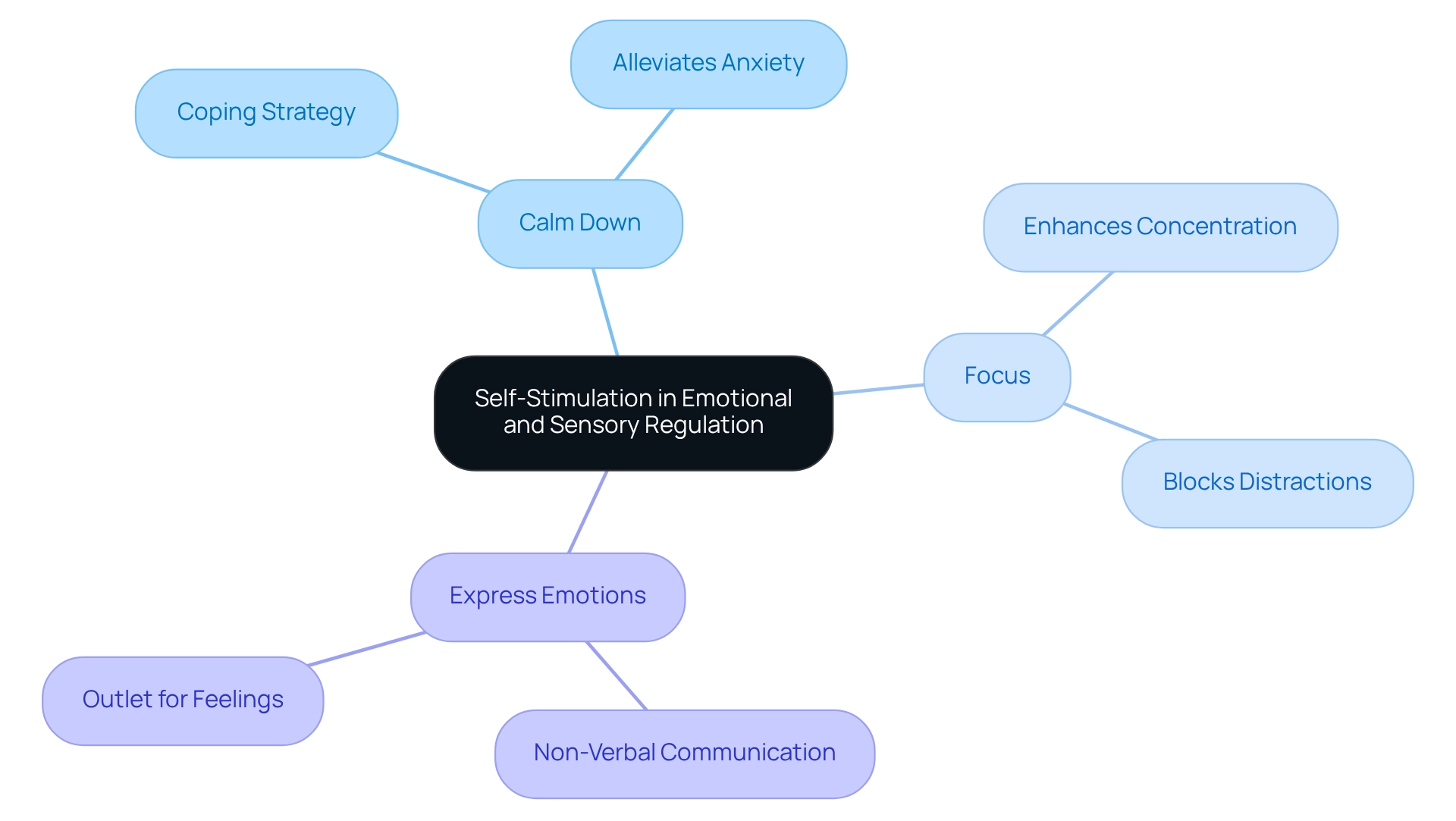
Identifying Triggers: What Leads to Self-Stimulation?
Understanding the common triggers for self-stimulating behaviors in individuals with autism can be incredibly helpful for caregivers. These triggers can be categorized into several key areas that warrant attention.
- Sensory Overload is one significant factor. Environments filled with loud noises, bright lights, or crowded spaces can lead to heightened levels of stimming. This behavior serves as a coping strategy, enabling individuals to manage overwhelming external stimuli. Research indicates that children with autism may thrive in regulated environments but struggle in challenging situations. This highlights the importance of being aware of these triggers. Parental observations often reveal the profound impact of sensory overload, with three main themes emerging from the data.
- Emotional Distress also plays a crucial role. Situations that provoke feelings of anxiety, frustration, or even excitement can trigger self-soothing behaviors as a way to regain control. A caregiver shared a poignant moment: ‘For example, once he was on the sidewalk, he got scared, actually he crossed all of a sudden and we had to catch him.’ This illustrates how emotional reactions can lead to actions aimed at self-regulation. Therapists emphasize the necessity of recognizing these emotional triggers and suggest strategies for managing autistic self-stimulation effectively.
- In moments of low engagement, individuals may resort to autistic self-stimulation to seek sensory input. This behavior can fill the void created by insufficient stimulation, underscoring the importance of providing suitable activities to maintain engagement. The case study titled "The Complex Sensory Experiences of Autistic Adults" highlights how differences in reactivity can impact individuals throughout their lives, emphasizing the need for tailored support services.
By identifying these triggers, caregivers can offer better support to their loved ones. Strategies may include minimizing overwhelming stimuli and introducing tailored sensory experiences, such as those found in Sensory Integration Therapy. This approach helps autistic children navigate their sensory processing challenges more effectively. Together, we can create environments that foster understanding and support for those we care about.
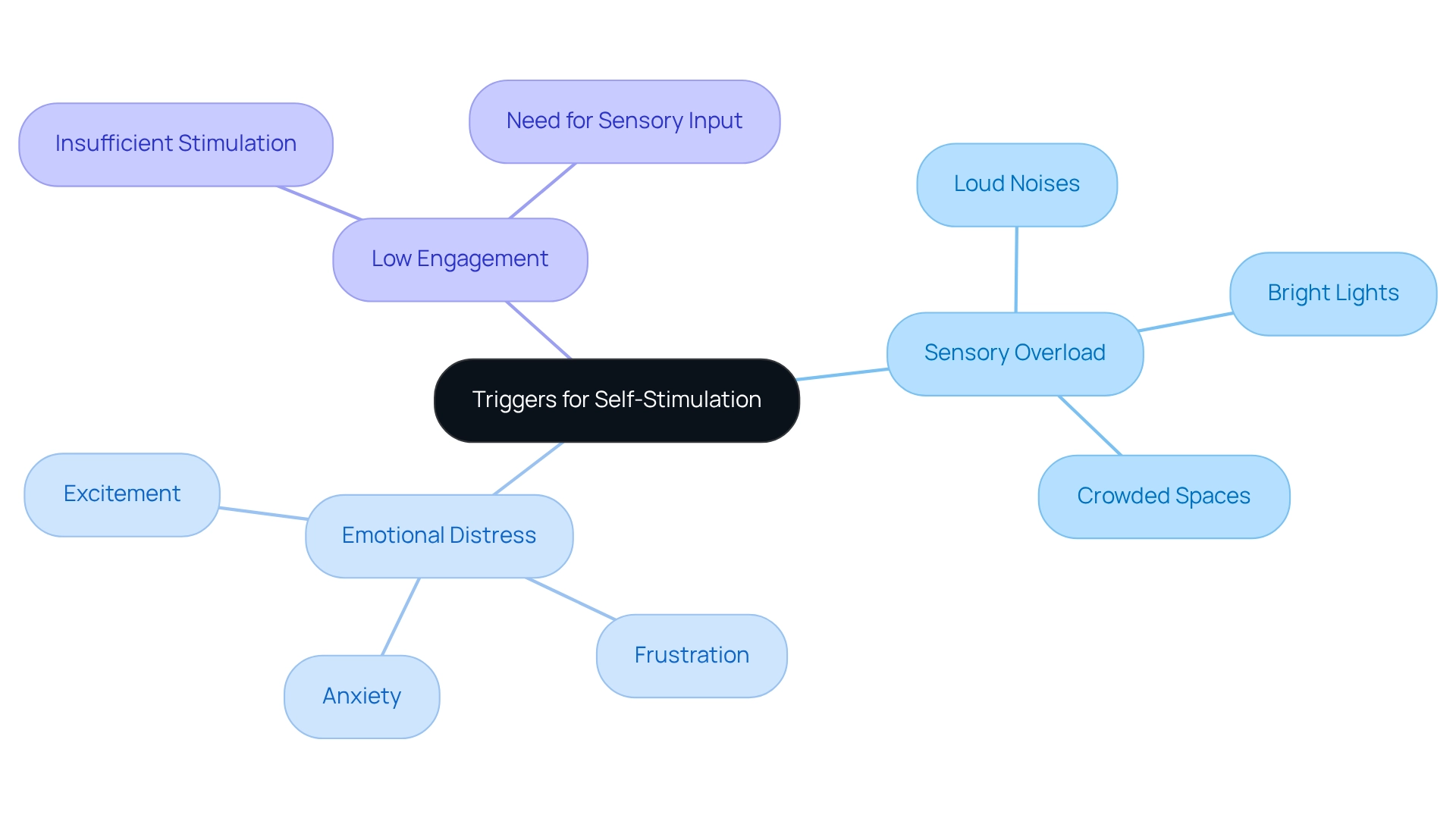
Challenges and Misconceptions: Understanding Self-Stimulation
Self-soothing actions, often referred to as sensory-seeking activities, come with a variety of challenges and misconceptions that can hinder understanding and acceptance. Let's explore some key issues together:
- Misunderstanding of Self-Stimulatory Actions: It’s a common misconception that self-stimulatory actions are negative and should be suppressed. In truth, these repetitive movements serve as a natural coping strategy for many autistic individuals, helping them navigate sensory overload and emotional distress through autistic self-stimulation. Recognizing autistic self-stimulation as a valid method of self-regulation is crucial for fostering acceptance.
- Social Stigma: Autistic individuals frequently encounter criticism and misinterpretation from society when engaging in self-soothing actions. This stigma can lead to feelings of isolation and anxiety, complicating their experiences even further. Research shows that autistic people face high rates of bullying, which can deeply affect their quality of life. Many have shared that they camouflage their autism in response to concerns about stigma. It's vital to address these societal perceptions to create a more inclusive environment. Future studies should consider an intersectional approach to better understand autism stigma within broader social contexts, offering deeper insights into the challenges faced by autistic individuals.
- Self-Injury Concerns: While some forms of autistic self-stimulation may appear self-injurious, it’s essential to differentiate between harmful behaviors and benign self-soothing activities. Caregivers should be educated to recognize the intent behind these actions, as many are aimed at providing comfort rather than causing harm. By grasping the nuances of autistic self-stimulation, caregivers can foster a supportive atmosphere that encourages healthy self-expression.
By addressing these misconceptions, caregivers can nurture a more understanding and supportive environment for autistic individuals, ultimately enhancing their well-being and quality of life. For instance, the case study of TreeTop ABA Therapy illustrates how home and community-based ABA therapy can empower families to seek resources and support, highlighting the importance of understanding sensory behaviors in the context of effective therapy. Together, we can make a difference in the lives of autistic individuals.
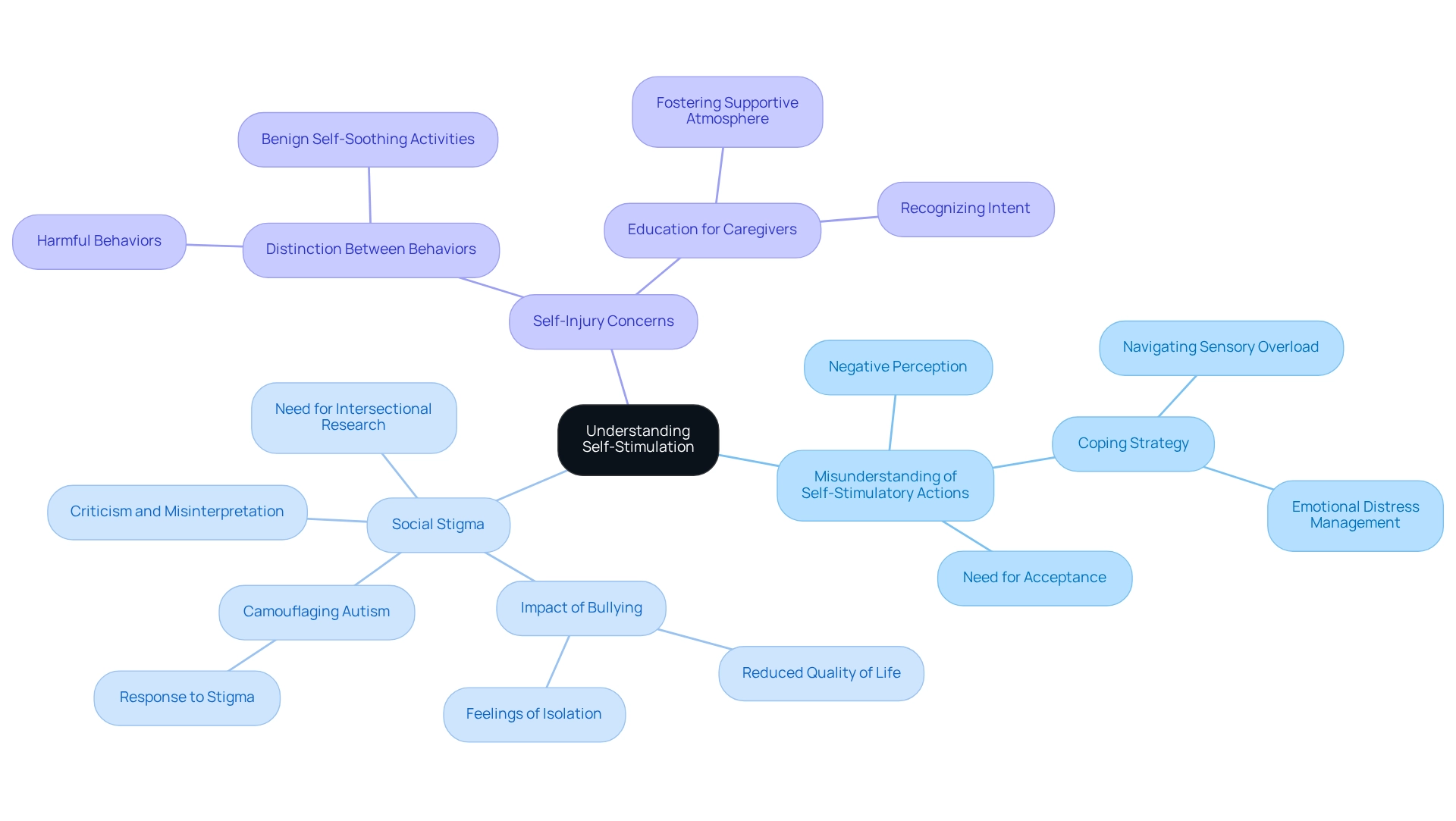
Effective Strategies for Managing Self-Stimulation
To effectively manage self-stimulating behaviors, caregivers can adopt several nurturing strategies that truly make a difference:
- Provide Alternatives: Introducing sensory toys or fidget tools can offer acceptable outlets for stimming. Research shows that tactile toys are especially beneficial for individuals seeking sensory input, as they assist in meeting such needs while reducing disruptive behaviors. A notable positive correlation has been identified between sensory seeking scores and the perception of fidget toys as helpful, emphasizing their vital role in managing sensory behaviors.
- Create a Routine: Establishing a consistent daily routine can significantly alleviate anxiety, which often triggers excessive stimming. A structured environment helps individuals feel secure and can lead to a reduction in self-stimulatory actions. The importance of processing interventions is underscored by findings that the SI group demonstrated more considerable progress in goal achievement, indicating that these strategies can be effective in therapeutic environments.
- Encourage Physical Activity: Regular physical exercise is essential for channeling excess energy, which can help mitigate the occurrence of stimming behaviors. Engaging in activities that promote movement not only supports physical health but also provides an alternative outlet for energy that might otherwise manifest as self-stimulation.
By implementing these strategies, caregivers can support their loved ones while respecting their inherent need for self-stimulation. For instance, a case study highlighted that children with varying Non-Verbal Intelligence Quotients (NVIQ) interacted differently with tactile equipment. This indicates that customized strategies based on personal profiles can enhance engagement and effectiveness. As noted by Springer Nature, '[insert quote here],' reinforcing the importance of understanding personal needs in the context of sensory toys.
By comprehending these dynamics, caregivers can more effectively promote positive experiences that honor the unique needs of autistic individuals. Together, let's embrace these approaches and create a nurturing environment that fosters growth and understanding.
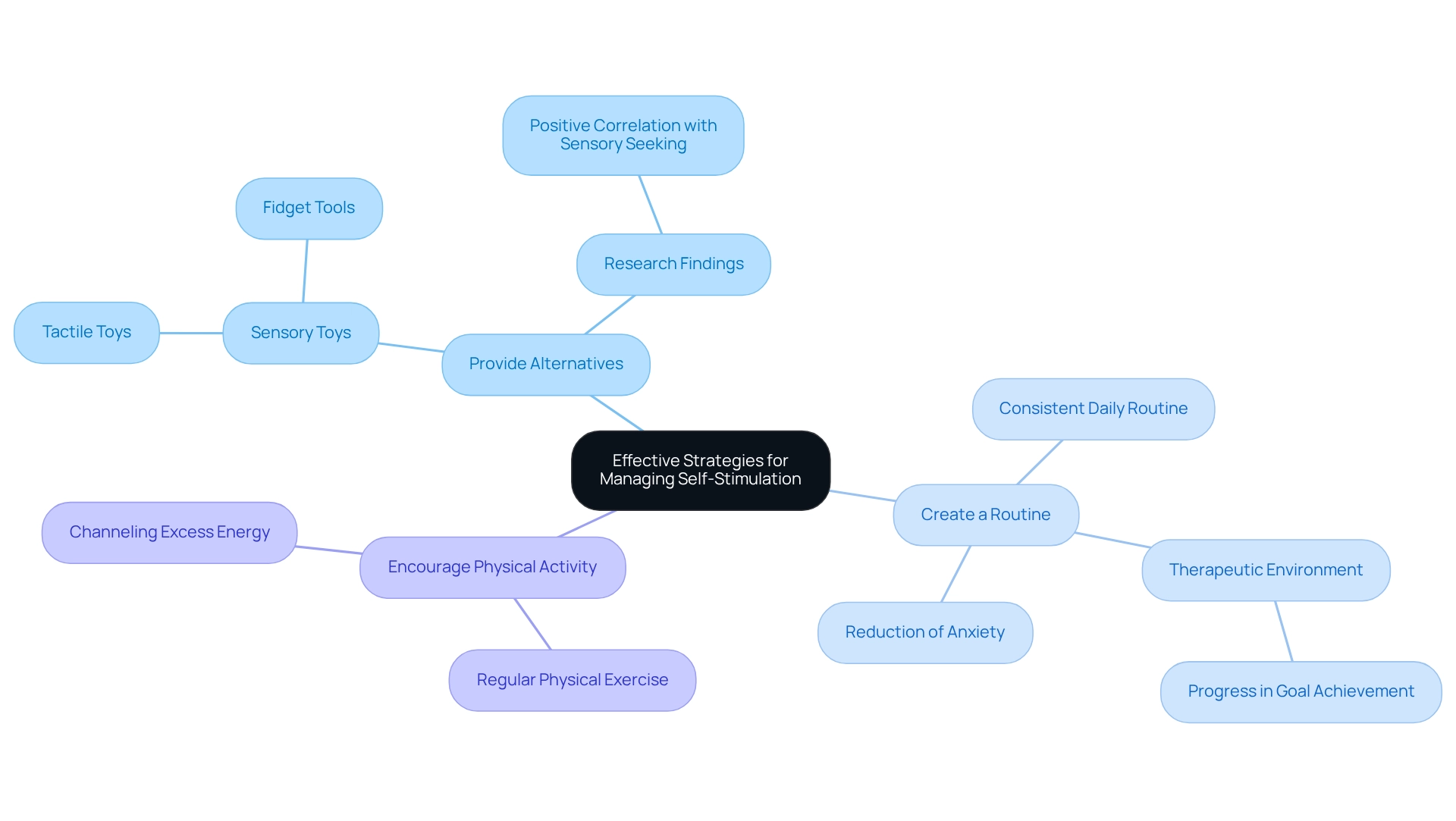
Creating Sensory-Friendly Environments: Tips for Caregivers
Creating sensory-friendly environments is vital for supporting individuals with autism, especially concerning their self-stimulation behaviors. As caregivers, you can take several meaningful steps to enhance these spaces:
- Reduce Noise Levels: Incorporating soft furnishings like rugs, curtains, and upholstered furniture can absorb sound and minimize echoes. This adjustment can significantly lower auditory distractions, which may often feel overwhelming for those who engage in self-stimulation. Research indicates that attention ratings on a scale of 0–2 show that higher scores correlate with more off-task behaviors, emphasizing the importance of reducing noise levels.
- Adjust Lighting: Whenever possible, favor natural light, and consider using soft, dimmable lighting options. Harsh fluorescent lights can be distressing, so creating a calming atmosphere with adjustable lighting can help lessen overwhelming stimuli.
- Designate Quiet Spaces: Establish specific areas within your home where individuals can retreat when feeling overwhelmed. These tranquil spaces should be furnished with soothing items, such as weighted blankets or noise-canceling headphones, to aid in emotional and perceptual management.
As Lady Rios-Vega noted, developing perceptual adaptive environments is crucial for enhancing care for children who experience self-stimulation. Furthermore, studies reveal that interventions focused on perception can significantly improve children's ability to handle sensitivities, leading to better engagement in daily tasks and social interactions. The study titled "Interventions for Sensory Processing Challenges in ASD" highlights the effectiveness of these therapies in real-world settings.
By implementing these strategies, you can create supportive environments that promote well-being and comfort for individuals with autism, thereby reducing the risk of negative social interactions that may arise from misunderstandings of sensory needs related to self-stimulation. Your efforts can make a profound difference in their lives.
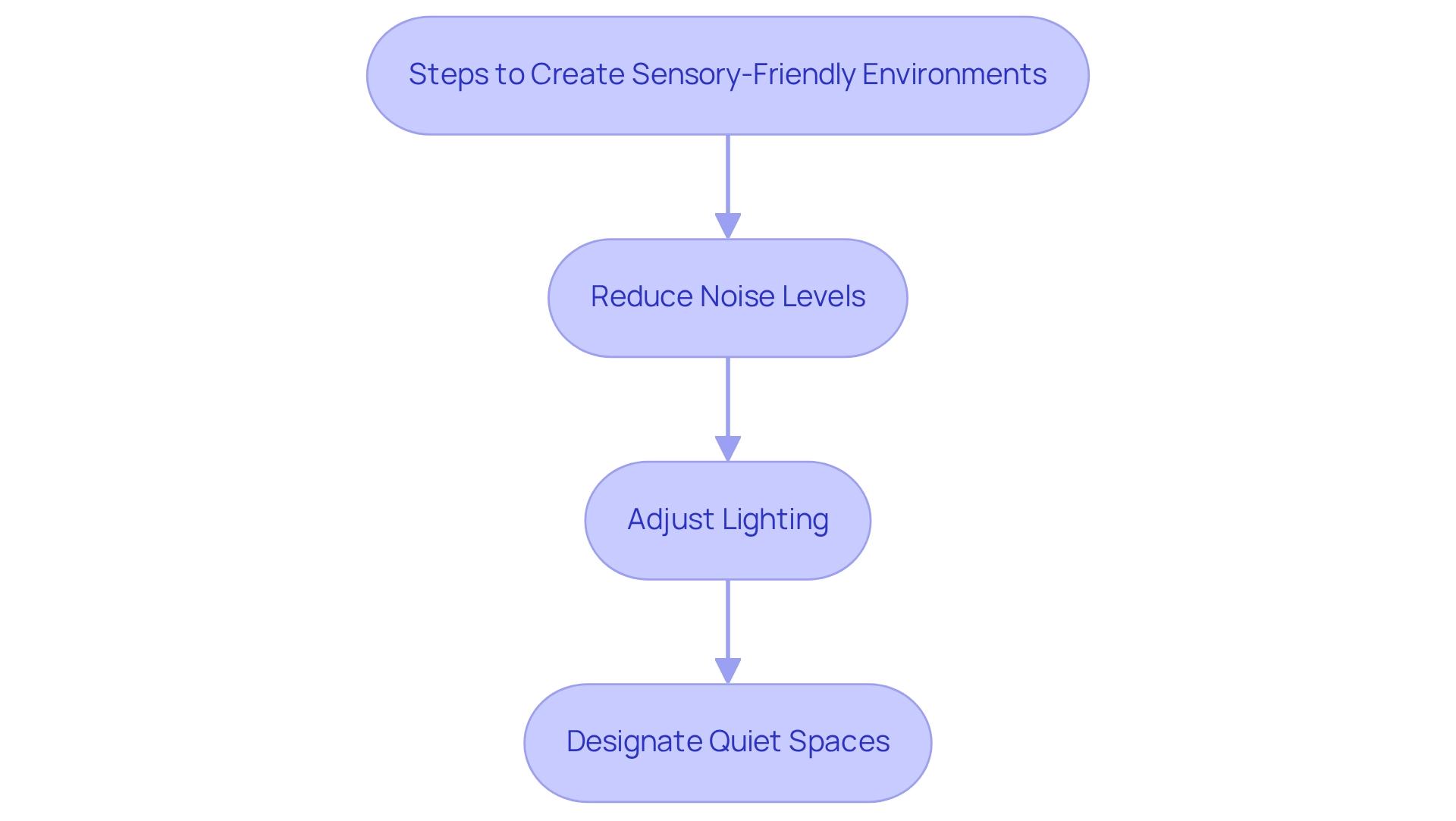
Collaborating with Professionals: Building a Support Network
Collaborating with professionals is vital for caregivers seeking valuable insights and resources to support their autistic children. Building a robust support network can make a significant difference in navigating the challenges faced. Here are effective strategies to consider:
- Engage with Therapists: Actively collaborating with ABA therapists or occupational therapists can help create personalized strategies for managing self-stimulatory behaviors. These professionals offer tailored interventions that address specific needs, enhancing the overall effectiveness of support.
- Join Support Groups: Connecting with other parents and caregivers through support groups provides a platform for sharing experiences, challenges, and resources. Research shows that participation in such groups can significantly reduce feelings of isolation and improve coping strategies among caregivers.
- Communicate with Educators: Establishing open lines of communication with teachers and school staff is crucial for ensuring consistent support across different environments. Regular discussions about the child's needs and progress facilitate the implementation of effective strategies in the classroom. However, it’s important to recognize that the female presentation of autism is often misunderstood by educators, which can lead to minimized concerns from parents.
A case study on the collaboration between health professionals and schools revealed a willingness to work together, yet the implementation of recommended supports in schools was often lacking due to teachers' busy schedules and limited understanding of autism. This underscores the necessity of persistent communication and advocacy from caregivers.
Moreover, as one expert noted, "In my experience, policymakers are not interested in disability; it’s not on the agenda... families should have access to inclusion specialists in the school, but this is often non-existent in reality." This highlights the systemic challenges caregivers face in securing adequate support for their children.
By promoting teamwork among therapists, educators, and other caregivers, we can greatly enhance the assistance offered to our loved ones, ultimately resulting in better outcomes for autistic children. Together, we can create a more supportive environment for all.
Continuing the Journey: Embracing Self-Stimulation in Autism
As caregivers embark on their journey with autistic individuals, it is vital to embrace self-stimulation as a natural and beneficial practice. Understanding stimming not only empowers caregivers but also promotes acceptance within their communities. By advocating for a deeper understanding of these behaviors, caregivers can help diminish stigma and cultivate an environment where stimming is accepted rather than suppressed. Research indicates that positive interactions with family members who understand self-stimulatory behaviors can significantly enhance the well-being of autistic individuals.
Caregivers should continuously assess and adapt their strategies for managing sensory-seeking behaviors, tailoring their approaches to meet the unique needs and preferences of each person. This adaptability is crucial, as studies show that autistic individuals often experience heightened sensory sensitivity and engage in self-soothing behaviors as a form of self-regulation. A recent study involving focus groups lasting approximately 60-90 minutes with six participants each underscored these experiences, highlighting the importance of personalized strategies.
Celebrating the diverse ways in which autistic individuals express themselves through repetitive behaviors is essential. By nurturing a culture of acceptance, caregivers empower their loved ones to flourish. Case studies reveal that embracing self-stimulation not only alleviates social pressure but also highlights the potential benefits of these behaviors, reinforcing the idea that such practices can be a positive aspect of an autistic individual's identity. As Steven K Kapp noted, "Greater understanding of such repetitive behaviors may, therefore, help elucidate appropriate support for a variety of people."
Through these efforts, caregivers can significantly contribute to promoting acceptance and understanding of repetitive actions, ultimately fostering a more inclusive community. A nuanced approach to stimming is essential, advocating for social acceptance rather than attempting to eliminate these behaviors. Together, we can create a supportive environment where every individual is valued for their unique expressions.
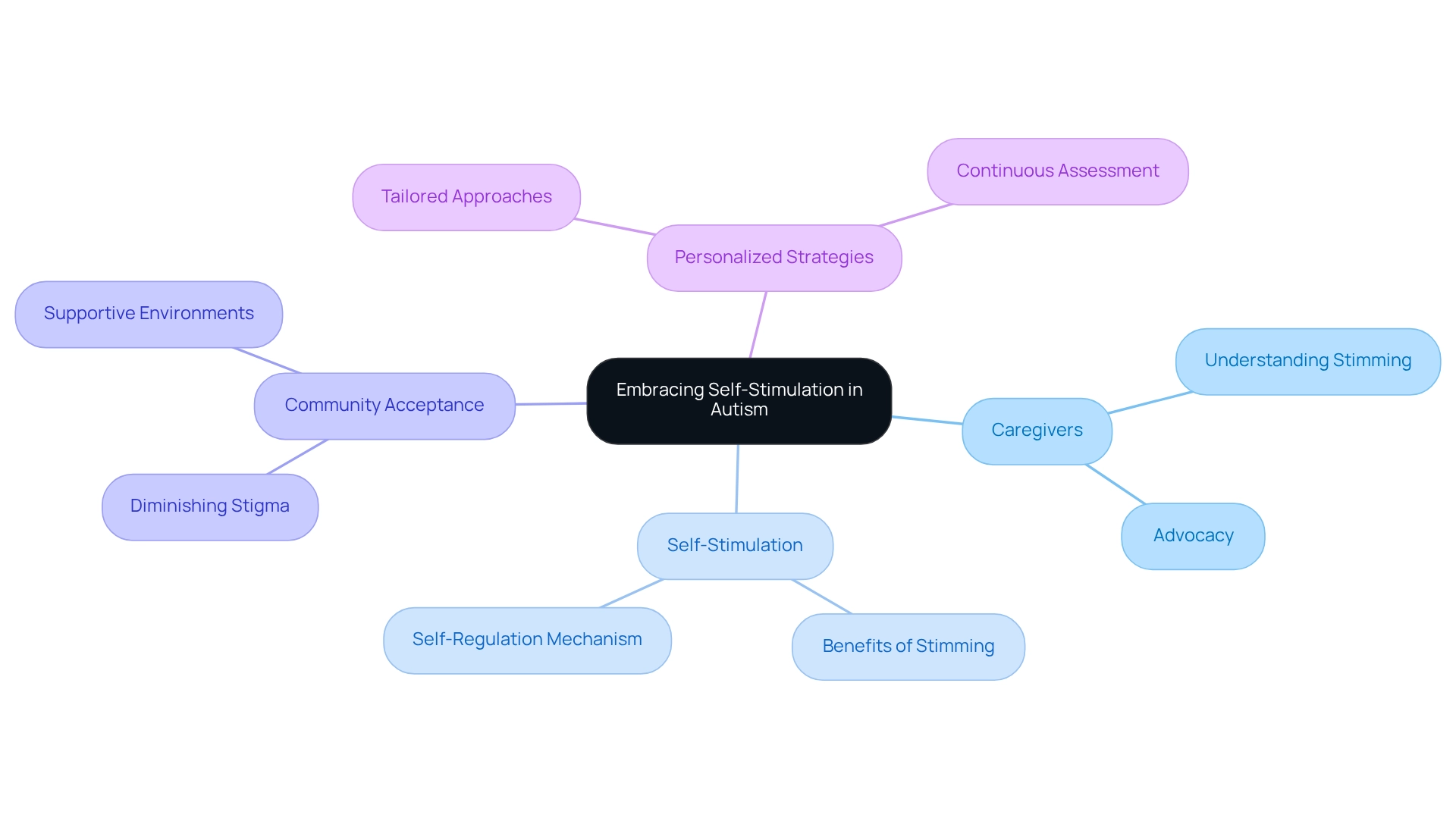
Conclusion
Recognizing the significance of self-stimulatory behaviors, or stimming, is essential for understanding the experiences of autistic individuals. These behaviors, which can include hand-flapping and vocalizations, serve vital functions such as self-soothing, emotional expression, and sensory regulation. By acknowledging stimming as a natural and beneficial aspect of autism, caregivers can create supportive environments that empower individuals to navigate their sensory and emotional landscapes more effectively.
The diverse categories of stimming highlight its complexity and the various needs it addresses, including sensory overload, emotional distress, and communication challenges. Understanding these motivations allows caregivers to respond with empathy and tailored strategies that respect the unique experiences of autistic individuals. By fostering an environment that embraces stimming, caregivers can not only enhance the quality of life for those on the spectrum but also combat societal misconceptions and stigma surrounding these behaviors.
Ultimately, the journey towards acceptance and understanding of stimming requires ongoing education and advocacy. Caregivers play a pivotal role in promoting awareness and acceptance within their communities, celebrating the uniqueness of autistic individuals and their self-stimulatory behaviors. By doing so, they contribute to a more inclusive society that recognizes the intrinsic value of stimming, transforming it from a misunderstood challenge into a meaningful expression of identity and self-regulation.
Frequently Asked Questions
What is self-stimulation in individuals with autism?
Self-stimulation, or autistic self-stimulation, includes repetitive actions such as hand-flapping, rocking, spinning, and vocalizations. These behaviors serve vital functions like self-soothing, sensory regulation, and emotional expression.
Why is understanding autistic self-stimulation important for caregivers?
Understanding autistic self-stimulation is crucial for caregivers as it represents a natural part of many individuals with autism's lives, providing insights into their emotional and sensory needs. It can help caregivers create supportive environments that empower autistic individuals to express themselves and manage their sensory experiences.
What are the benefits of self-stimulation behaviors for autistic individuals?
Research indicates that engaging in self-stimulation behaviors can significantly alleviate anxiety and emotional distress, leading to improvements in overall well-being for autistic individuals.
What percentage of people with autism spectrum disorder exhibit profound autism?
The Centers for Disease Control and Prevention (CDC) reports that 26.7% of people with autism spectrum disorder exhibit profound autism, characterized by nonverbal communication and lower adaptive functioning.
What types of self-stimulatory actions are there?
There are several types of self-stimulatory actions, including: Visual Stimming: Watching spinning objects or flickering lights. Auditory Stimming: Producing repetitive sounds or noises. Tactile Stimming: Interacting with different textures. Vestibular Stimming: Movements involving balance, such as rocking or swinging. Proprioceptive Stimming: Actions that provide body awareness, like jumping or pushing against objects.
How do self-stimulation behaviors help with sensory and emotional regulation?
Self-stimulation behaviors help individuals cope with sensory overload and manage emotions. They provide comfort and a way to navigate emotional states, acting as a form of self-soothing during overwhelming moments.
Can self-stimulation serve as a form of communication?
Yes, for some individuals, self-stimulation can serve as a non-verbal form of communication to express emotions or needs, especially when verbal interaction is challenging.
What is the significance of recognizing and valuing self-stimulatory behaviors?
Recognizing and valuing self-stimulatory behaviors as forms of communication and self-regulation can lead to tailored strategies in therapy and support, enhancing the quality of life for those on the autism spectrum.




